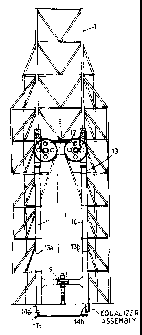Some of the information on this Web page has been provided by external sources. The Government of Canada is not responsible for the accuracy, reliability or currency of the information supplied by external sources. Users wishing to rely upon this information should consult directly with the source of the information. Content provided by external sources is not subject to official languages, privacy and accessibility requirements.
Any discrepancies in the text and image of the Claims and Abstract are due to differing posting times. Text of the Claims and Abstract are posted:
| (12) Patent: | (11) CA 2240797 |
|---|---|
| (54) English Title: | STRETCH COMPENSATION IN A HOISTING SYSTEM FOR A DERRICK |
| (54) French Title: | COMPENSATION DE TRACTION DANS UN DISPOSITIF DE LEVAGE DE DERRICK |
| Status: | Expired and beyond the Period of Reversal |
| (51) International Patent Classification (IPC): |
|
|---|---|
| (72) Inventors : |
|
| (73) Owners : |
|
| (71) Applicants : |
|
| (74) Agent: | MCCARTHY TETRAULT LLP |
| (74) Associate agent: | |
| (45) Issued: | 2004-12-14 |
| (86) PCT Filing Date: | 1996-12-23 |
| (87) Open to Public Inspection: | 1997-07-10 |
| Examination requested: | 2001-12-03 |
| Availability of licence: | N/A |
| Dedicated to the Public: | N/A |
| (25) Language of filing: | English |
| Patent Cooperation Treaty (PCT): | Yes |
|---|---|
| (86) PCT Filing Number: | PCT/NO1996/000310 |
| (87) International Publication Number: | WO 1997024507 |
| (85) National Entry: | 1998-06-18 |
| (30) Application Priority Data: | ||||||
|---|---|---|---|---|---|---|
|
An apparatus for a derrick, comprising two or more hydraulic piston-cylinder
arrangements (10, 11) for raising and lowering a yoke (8) which travels on
guide rails
(7) in the derrick (1) itself, where two or more wire lines (13) are strung
over sheaves (12)
rotatably attached to the yoke. The wire lines (13) are attached at one end
thereof to the
top drive (9) and at the other end thereof are secured to an attachment point
(14a, 14b)
adjacent to a drill floor (2), said two or more wire lines being run in two
sets (13a, 13b)
of lines. The attachment points (14a, 14b) for each wire set are connected to
a tension
equalizer assembly to equalize differences in tension in the wire lines.
L'invention porte sur un appareil destiné à un derrick, comportant deux mécanismes hydrauliques à piston-cylindre (10, 11), destinés à faire monter et descendre un joug (8) se déplaçant sur des rails de guidage (7) situés sur le derrick (1) lui-même, deux filins (13) ou davantage étant tendus sur des poulies (12) montées rotatives sur le joug. Les filins (13) sont attachés par l'une de leurs extrémités à un mécanisme supérieur d'entraînement (9) et assujettis par l'autre extrémité à un point de fixation (14a, 14b) contigu au plancher (2) d'un outil de forage, lesdits filins, deux à tout le moins, étant agencés en deux ensembles (13a, 13b). Les points de fixation (14a, 14b) de chaque ensemble de filins sont rattachés à un ensemble d'égalisation des tensions destiné à équilibrer des différences de tension existant entre les filins.
Note: Claims are shown in the official language in which they were submitted.
Note: Descriptions are shown in the official language in which they were submitted.

2024-08-01:As part of the Next Generation Patents (NGP) transition, the Canadian Patents Database (CPD) now contains a more detailed Event History, which replicates the Event Log of our new back-office solution.
Please note that "Inactive:" events refers to events no longer in use in our new back-office solution.
For a clearer understanding of the status of the application/patent presented on this page, the site Disclaimer , as well as the definitions for Patent , Event History , Maintenance Fee and Payment History should be consulted.
| Description | Date |
|---|---|
| Time Limit for Reversal Expired | 2016-12-23 |
| Letter Sent | 2015-12-23 |
| Letter Sent | 2007-02-22 |
| Inactive: Multiple transfers | 2007-01-09 |
| Inactive: IPC from MCD | 2006-03-12 |
| Inactive: IPC from MCD | 2006-03-12 |
| Grant by Issuance | 2004-12-14 |
| Inactive: Cover page published | 2004-12-13 |
| Pre-grant | 2004-10-04 |
| Inactive: Final fee received | 2004-10-04 |
| Notice of Allowance is Issued | 2004-04-15 |
| Letter Sent | 2004-04-15 |
| Notice of Allowance is Issued | 2004-04-15 |
| Inactive: Approved for allowance (AFA) | 2004-03-31 |
| Letter Sent | 2002-01-09 |
| Request for Examination Received | 2001-12-03 |
| Request for Examination Requirements Determined Compliant | 2001-12-03 |
| All Requirements for Examination Determined Compliant | 2001-12-03 |
| Amendment Received - Voluntary Amendment | 2001-12-03 |
| Inactive: IPC assigned | 1998-09-28 |
| Inactive: First IPC assigned | 1998-09-28 |
| Classification Modified | 1998-09-28 |
| Inactive: IPC assigned | 1998-09-28 |
| Inactive: IPC assigned | 1998-09-28 |
| Inactive: Notice - National entry - No RFE | 1998-09-02 |
| Application Received - PCT | 1998-08-26 |
| Application Published (Open to Public Inspection) | 1997-07-10 |
There is no abandonment history.
The last payment was received on 2003-11-27
Note : If the full payment has not been received on or before the date indicated, a further fee may be required which may be one of the following
Please refer to the CIPO Patent Fees web page to see all current fee amounts.
Note: Records showing the ownership history in alphabetical order.
| Current Owners on Record |
|---|
| AKER KVAERNER MH AS |
| Past Owners on Record |
|---|
| PER VATNE |